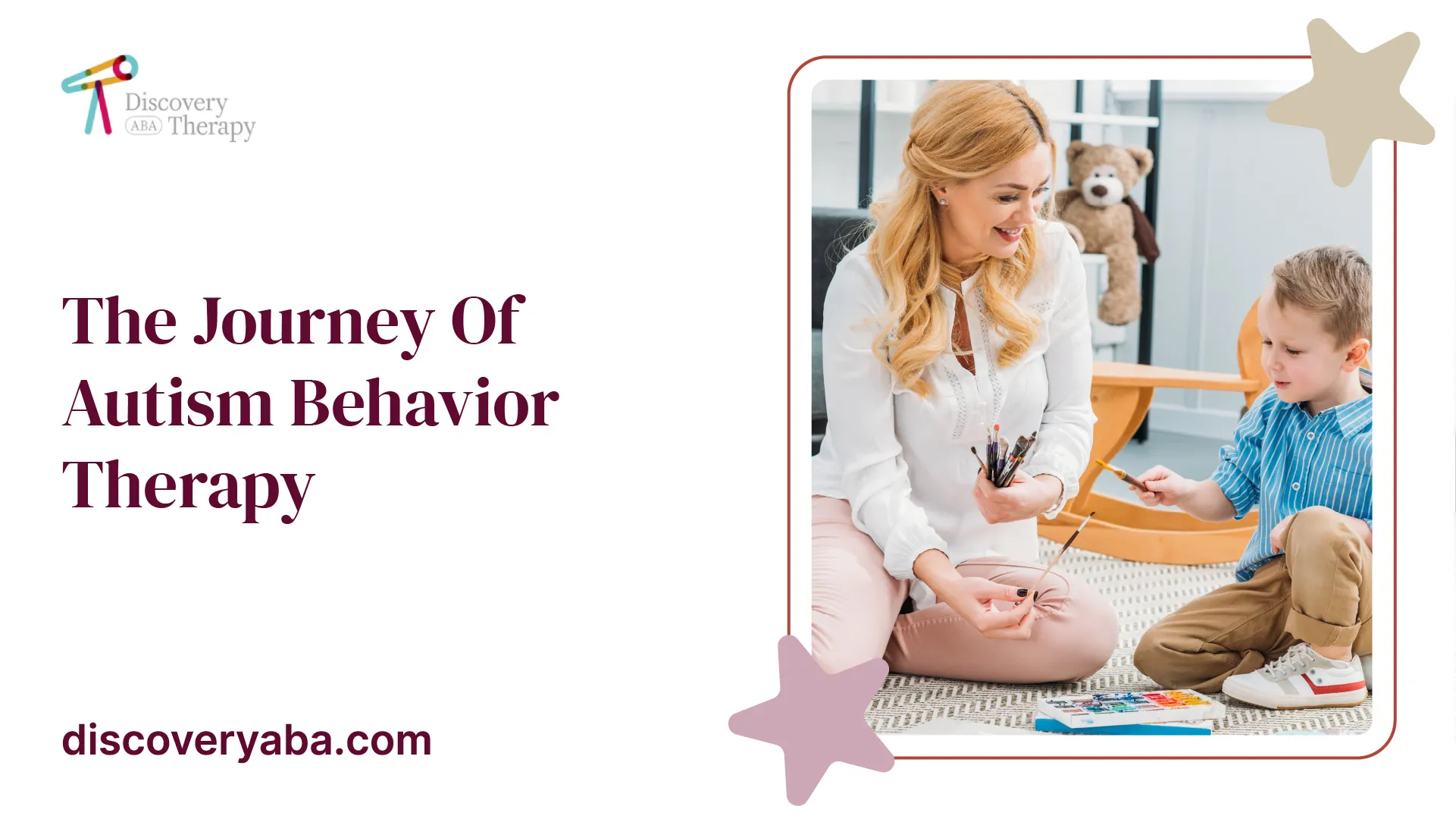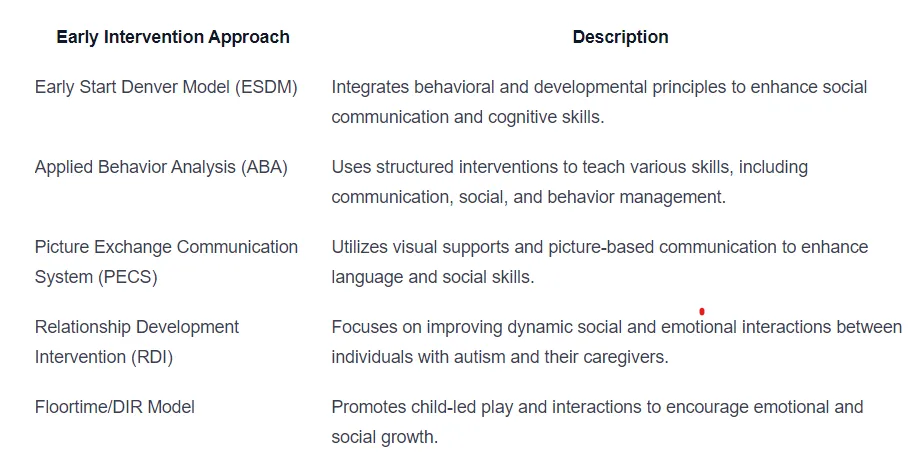The Journey of Autism Behavior Therapy
Unlock the triumphs of autism behavior therapy! Discover effective strategies and tailored interventions for a brighter future.

Behavioral Therapy Overview
When it comes to treating autism spectrum disorder (ASD), behavioral therapy plays a fundamental role in helping individuals with autism develop essential skills and manage challenging behaviors. Behavioral therapy focuses on reinforcing desired behaviors and reducing unwanted behaviors through various strategies implemented by caregivers. These strategies are typically carried out before, during, after, and between episodes of problem behaviors.
Understanding Autism Behaviors is a crucial first step in providing effective behavioral therapy. Each individual with autism may exhibit a unique set of behaviors, and it is important to identify and address these behaviors to create tailored therapy plans that cater to their specific needs.

Behavioral therapy commonly follows the principles of Applied Behavior Analysis (ABA). ABA is a widely accepted approach in behavioral therapy for autism, tracking a child's progress in improving various skills. By observing and analyzing behaviors, ABA aims to identify the antecedents and consequences that influence behaviors. This understanding helps in developing and implementing effective interventions and strategies to promote positive behaviors and reduce challenging ones.
Understanding Autism Behaviors
Autism behaviors can vary widely among individuals, and a comprehensive understanding of these behaviors is crucial for effective behavioral therapy. Some common behaviors associated with autism spectrum disorder include:
- Repetitive behaviors: Individuals with autism may engage in repetitive behaviors such as hand-flapping, rocking, or repeating certain words or phrases.
- Restricted interests: They may display intense interests in specific topics or objects while showing minimal interest in other activities.
- Social communication challenges: Difficulties in social interactions, including limited eye contact, challenges in understanding and using nonverbal cues, and difficulty engaging in reciprocal conversations, are often observed.
- Sensory sensitivities: Many individuals with autism may experience heightened sensitivities to sensory stimuli, such as loud noises, bright lights, or certain textures.
Understanding these behaviors and their underlying causes allows behavioral therapists to develop tailored interventions that address the specific needs and challenges of individuals with autism. By reinforcing desired behaviors and implementing strategies to reduce challenging behaviors, behavioral therapy aims to improve life skills, intellectual abilities, and social skills for individuals with autism.
By utilizing Applied Behavior Analysis and understanding the unique behaviors exhibited by individuals with autism, behavioral therapy can provide a structured and effective approach to improving the lives of individuals on the autism spectrum.
Applied Behavior Analysis (ABA)
Applied Behavior Analysis (ABA) is a widely accepted and evidence-based approach for behavioral therapy in autism spectrum disorder (ASD). ABA focuses on reinforcing desired behaviors and reducing unwanted behaviors by caregivers through various strategies. It provides guidance to caregivers on actions to take before, during, after, and between episodes of problem behaviors. This approach aims to track a child's progress in improving skills.
The Effectiveness of ABA
ABA has demonstrated effectiveness in helping individuals with ASD improve their skills and reduce challenging behaviors. Numerous studies have shown the positive impact of ABA interventions on various aspects of autism behaviors, including communication, social skills, daily living skills, and academic performance. The goal of ABA is to enhance the individual's quality of life by promoting positive behaviors and reducing behaviors that may hinder their development and social interactions.
Types of ABA Therapies
There are different types of ABA therapies that can be tailored to meet the specific needs of individuals with ASD. These therapies encompass a range of techniques and strategies, allowing for a versatile approach to managing autism behaviors. Some common types of ABA therapies include:
- Discrete Trial Training (DTT): DTT breaks down skills into smaller, more manageable components and teaches them in a structured manner. It involves a series of trials with clear instructions, prompts, and reinforcements to encourage the acquisition of new skills.
- Naturalistic Teaching: Naturalistic teaching focuses on incorporating learning opportunities naturally within the individual's environment. It emphasizes using the individual's interests and motivations to promote learning and generalization of skills.
- Pivotal Response Training (PRT): PRT targets pivotal areas of development, such as motivation, initiation, and self-regulation. It aims to improve these core areas to facilitate overall skill development and independence.
- Incidental Teaching: Incidental teaching capitalizes on naturally occurring situations to encourage learning. It involves creating opportunities for the individual to initiate communication or engage in desired behaviors, with the therapist providing prompts and reinforcement.
- Verbal Behavior Therapy: Verbal behavior therapy focuses on teaching functional communication skills, such as requesting, labeling, and social interactions. It emphasizes the functional use of language and helps individuals with ASD develop effective communication strategies.
These are just a few examples of the types of ABA therapies available. The selection of the most appropriate therapy depends on the individual's specific needs, strengths, and challenges. A qualified ABA therapist can assess the individual and create a customized treatment plan that best suits their requirements.
By utilizing the effectiveness of ABA and exploring the different types of ABA therapies, individuals with ASD can benefit from targeted interventions that address their unique behaviors and promote their overall development.
Beyond ABA
While Applied Behavior Analysis (ABA) is widely recognized as an effective therapy for individuals with autism spectrum disorder (ASD), there are also alternative behavioral therapies available that can complement or supplement ABA. These alternative therapies offer a range of options for managing autism behaviors, allowing for a more tailored approach to meet the individual's specific needs.
Alternative Behavioral Therapies
Beyond ABA, several alternative behavioral therapies have shown promise in addressing the challenges associated with ASD. These therapies focus on various aspects of behavior and development, providing additional options for individuals with autism. Some of the alternative behavioral therapies include:
- Early Intensive Behavioral Intervention (EIBI): This therapy has been found to be particularly effective in improving intelligence and adaptive behaviors in individuals with ASD. EIBI involves a highly structured and intensive approach, typically starting before the age of five, to target various developmental areas.
- Naturalistic Developmental Behavioral Intervention (NDBI): NDBI is designed to enhance social and communication abilities. It focuses on creating natural learning opportunities within the individual's everyday environment. Studies have shown that NDBI can improve language, cognitive function, and social initiation in individuals with ASD.
- Intensive Individualized Intervention: This approach provides a tailored intervention for a specific target behavior. It involves a highly individualized program that addresses the unique needs of the individual with ASD. Intensive individualized intervention has been effective in improving social skills, communication, and reducing problematic behaviors such as sleep, eating, and toileting difficulties.
These alternative behavioral therapies offer additional options for individuals with ASD and their families, allowing for a comprehensive and personalized treatment plan.
Tailoring Therapies to Needs
When considering the appropriate behavioral therapy for an individual with ASD, it is crucial to tailor the therapy to their specific needs. Each person with autism is unique, and what works for one individual may not be as effective for another. Understanding the individual's strengths, challenges, and preferences is essential in selecting the most appropriate therapy.
A comprehensive assessment by a qualified professional can help determine which therapy or combination of therapies would be the most beneficial for the individual. This assessment may involve considering the individual's age, cognitive abilities, language skills, and social development. By understanding the specific profile of the individual with ASD, therapists can customize the therapy to address their unique needs and goals.
It is important to note that while alternative behavioral therapies can be valuable additions to a treatment plan, they should not replace evidence-based approaches like ABA. The combination of different therapies, when used in a coordinated and integrated manner, can provide a comprehensive approach to address the diverse range of autism behaviors.
By embracing alternative behavioral therapies and tailoring them to an individual's needs, it is possible to enhance the effectiveness of interventions and support the development and well-being of individuals with autism spectrum disorder.
Early Intervention Strategies
When it comes to autism behavior therapy, early intervention plays a crucial role in promoting positive outcomes for individuals with autism spectrum disorder (ASD). Research has shown that early diagnosis and interventions are more likely to have major long-term positive effects on symptoms and later skills. Initiating integrated developmental and behavioral interventions as soon as ASD is diagnosed or suspected is recommended to enhance learning and progress.
Importance of Early Interventions
Early interventions for autism aim to provide children with the best start possible and the best chance of developing to their full potential. Starting interventions as early as possible, ideally at or before preschool age, allows for better long-term effectiveness by taking advantage of the brain's plasticity.
Research suggests that with early intervention, some children with autism make significant progress and may no longer exhibit symptoms of autism as they grow older. In fact, some children who no longer fall on the autism spectrum exhibit common characteristics. Early intervention programs for children with autism aim to help them acquire basic skills usually learned in the first 2 years of life.
Effective Early Intervention Approaches
Early intervention approaches for autism focus on providing children with the necessary tools and support to enhance their development. Each state in the U.S. has its own early intervention program specified by Part C of the Individuals with Disabilities Education Improvement Act, also known as "IDEA". These programs offer services for children diagnosed with developmental delays or autism spectrum disorder (ASD), as well as those at risk for developmental delays and disabilities.
Parent-mediated interventions have shown promise in early intervention strategies for autism. These interventions focus on improving parent responsiveness and enhancing infant attention and engagement. Teaching parents to better identify their child's early attempts at communication and social engagement has been associated with growth in social and communication skills in children receiving the intervention.
The table below provides an overview of effective early intervention approaches for autism:

By implementing early intervention strategies tailored to the specific needs of children with autism, it is possible to make significant progress in their development and improve their long-term outcomes. Early interventions not only provide children with important skills but also empower families to support their child's growth and development journey.
Parental Involvement
Parents play a crucial role in the success of autism behavior therapy. Their involvement and active participation in their child's therapy can greatly enhance the effectiveness of interventions. In this section, we will explore two aspects of parental involvement in autism behavior therapy: parent-mediated interventions and enhancing child development.
Parent-Mediated Interventions
Parent-mediated intervention (PMI) is an approach that involves parents acquiring knowledge and specific skills to improve their child's functioning or reduce challenging behaviors in individuals with autism spectrum disorder (ASD). This type of intervention recognizes that parents have a unique understanding of their child's strengths, challenges, and individual needs.
Through parent-mediated interventions, parents are taught strategies and techniques to support their child's development and address specific goals. These interventions focus on improving parent responsiveness, communication skills, and interaction patterns with their child. Teaching parents to better identify their child's early attempts at communication and social engagement is a key component of early intervention approaches for autism. By enriching the child's environment through active parental involvement, these interventions have been associated with growth in social and communication skills in children receiving the intervention.
Parent-mediated interventions can be particularly beneficial when implemented early in a child's life. Research suggests that early intervention for infants showing developmental signs of autism risk may support their developmental trajectories and improve parent responsiveness, infant attention, and engagement. However, accurate and stable long-term diagnostic methods for autism in toddlers and infants are still being developed, highlighting the importance of ongoing research and accurate diagnoses for effective early intervention [5].
Enhancing Child Development
Parental involvement in autism behavior therapy goes beyond specific interventions. Parents can actively support their child's development by creating a nurturing and supportive environment. This involves providing opportunities for social interaction, communication, and sensory experiences that promote overall growth.
Parents can engage in activities that enhance their child's development, such as reading books together, engaging in imaginative play, and encouraging age-appropriate social interactions. These activities can help improve language skills, social cognition, and emotional regulation.
It's also important for parents to work closely with therapists and professionals to understand their child's individual goals and needs. By maintaining open communication and actively participating in therapy sessions, parents can reinforce the strategies and techniques learned during therapy sessions in their day-to-day interactions with their child.
By actively participating in their child's therapy and creating a supportive environment at home, parents can significantly contribute to the progress and overall well-being of their child with autism. The collaboration between parents and professionals is vital in ensuring a comprehensive and effective approach to autism behavior therapy.
Cognitive Behavioral Therapy (CBT)
Cognitive Behavioral Therapy (CBT) has emerged as a highly effective method for addressing emotional difficulties in individuals with Autism Spectrum Disorder (ASD). This therapeutic approach focuses on identifying and modifying negative thoughts, emotions, and behaviors, and has shown promise in improving the overall well-being of individuals with ASD.
CBT for Emotional Difficulties
Individuals with ASD often experience emotional difficulties that can significantly impact their daily lives. CBT provides a structured framework to address these challenges and develop coping strategies. Research has shown that CBT can effectively target emotional difficulties such as anxiety, depression, and obsessive-compulsive behaviors in individuals with ASD and comorbid conditions. In fact, OCD occurs as a comorbid condition in 37% of individuals with ASD.
The treatment components of CBT typically include psychoeducation, fear hierarchy development, exposure/response prevention, cognitive strategies, and generalization/relapse prevention. However, modifications to the standard CBT protocol have been found to enhance its effectiveness for individuals with ASD. These modifications may include increased structure in the sessions, visual aids and cues, incorporation of child interests, personalized treatment metaphors and coping statements, self-monitoring, positive reinforcement, use of clear language and instructions, and considerable parental involvement.
Enhancing CBT Effectiveness
To optimize the effectiveness of CBT for individuals with ASD, various enhancements can be implemented. Parental involvement plays a crucial role in supporting the child's progress and generalization of skills outside of therapy sessions. It allows for consistency and reinforcement of learned strategies in real-life situations. Additionally, using visuals, personalized treatment metaphors, self-monitoring techniques, positive reinforcement, and clear language and instructions can improve engagement and comprehension for individuals with ASD [6].
Moreover, CBT can be tailored to address the specific needs and interests of individuals with ASD. Incorporating their interests and utilizing personalized treatment metaphors can enhance motivation and facilitate better understanding of the therapeutic concepts. By adapting the treatment to the unique characteristics of each individual, CBT becomes more meaningful and impactful.
It is worth noting that the success of CBT for individuals with ASD relies on a collaborative approach between the therapist, the individual, and their family or caregivers. By working together, the therapy can be customized to suit the individual's needs and ensure optimal outcomes.
With its evidence-based approach, CBT offers individuals with ASD valuable tools to manage their emotional difficulties and improve their overall quality of life. By addressing negative thoughts, emotions, and behaviors, CBT empowers individuals to navigate the challenges they face and develop effective coping strategies.
References
- https://www.nichd.nih.gov/health/topics/autism/conditioninfo/treatments/behavioral-management
- https://www.helpguide.org/articles/autism-learning-disabilities/autism-treatments-therapies-interventions.htm
- https://www.ncbi.nlm.nih.gov/pmc/articles/PMC10774556/
- https://www.nichd.nih.gov/health/topics/autism/conditioninfo/treatments/early-intervention
- https://www.spectrumnews.org/opinion/cross-talk/how-early-should-autism-treatment-begin/
- https://www.ncbi.nlm.nih.gov/pmc/articles/PMC5858576/
Does Your Child Have An Autism Diagnosis?
Learn More About How ABA Therapy Can Help
Find More Articles
Contact us
North Carolina, Nevada, Utah, Virginia
New Hampshire, Maine
Arizona, Colorado, Georgia, New Mexico, Oklahoma, Texas
.avif)




































































































